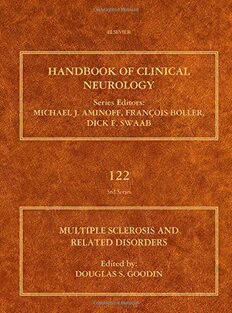
Multiple Sclerosis and Related Disorders PDF
Preview Multiple Sclerosis and Related Disorders
HANDBOOK OF CLINICAL NEUROLOGY Series Editors MICHAEL J. AMINOFF, FRANC¸OIS BOLLER, AND DICK F. SWAAB VOLUME 122 EDINBURGH LONDON NEW YORK OXFORD PHILADELPHIA ST LOUIS SYDNEY TORONTO 2014 ELSEVIERB.V. Radarweg29,1043NX,Amsterdam,TheNetherlands ©2014,ElsevierB.V.Allrightsreserved. Nopartofthispublicationmaybereproducedortransmittedinanyformorbyanymeans,electronicor mechanical,includingphotocopying,recording,oranyinformationstorageandretrievalsystem,without permissioninwritingfromthepublisher.PermissionsmaybesoughtdirectlyfromElsevier’sRightsDepartment: phone:(þ1)2152393804(US)or(þ44)1865843830(UK);fax:(þ44)1865853333;e-mail: healthpermissions@elsevier.com.Youmayalsocompleteyourrequeston-lineviatheElsevierwebsiteat http://www.elsevier.com/permissions. ThisbookandtheindividualcontributionscontainedinitareprotectedundercopyrightbythePublisher(otherthan asmaybenotedherein). ISBN:9780444520012 BritishLibraryCataloguinginPublicationData AcataloguerecordforthisbookisavailablefromtheBritishLibrary LibraryofCongressCataloginginPublicationData AcatalogrecordforthisbookisavailablefromtheLibraryofCongress Notice Knowledgeandbestpracticeinthisfieldareconstantlychanging.Asnewresearchandexperiencebroadenour understanding,changesinresearchmethods,professionalpractices,ormedicaltreatmentmaybecomenecessary. Practitionersandresearchersmustalwaysrelyontheirownexperienceandknowledgeinevaluatingandusingany information,methods,compounds,orexperimentsdescribedherein.Inusingsuchinformationormethodsthey shouldbemindfuloftheirownsafetyandthesafetyofothers,includingpartiesforwhomtheyhaveaprofessional responsibility. Withrespecttoanydrugorpharmaceuticalproductsidentified,readersareadvisedtocheckthemostcurrent informationprovided(i)onproceduresfeaturedor(ii)bythemanufacturerofeachproducttobeadministered,to verifytherecommendeddoseorformula,themethodanddurationofadministration,andcontraindications.Itisthe responsibilityofpractitioners,relyingontheirownexperienceandknowledgeoftheirpatients,tomakediagnoses, todeterminedosagesandthebesttreatmentforeachindividualpatient,andtotakeallappropriatesafety precautions. Tothefullestextentofthelaw,neitherthePublishernorthecontributorsoreditors,assumeanyliabilityforany injuryand/ordamagetopersonsorpropertyasamatterofproductsliability,negligenceorotherwise,orfromany useoroperationofanymethods,products,instructions,orideascontainedinthematerialherein. ThePublisher PrintedinChina The Publisher's CommissioningEditor:ThomasE.Stone policy is to use DevelopmentEditor:MichaelParkinson paper manufactured from sustainable forests ProjectManager:SujathaThirugnanaSambandam Designer/DesignDirection:AlanStudholme HandbookofClinicalNeurology3rdSeries Availabletitles Vol.79,Thehumanhypothalamus:basicandclinicalaspects,PartI,D.F.SwaabISBN9780444513571 Vol.80,Thehumanhypothalamus:basicandclinicalaspects,PartII,D.F.SwaabISBN9780444514905 Vol.81,Pain,F.CerveroandT.S.Jensen,eds.ISBN9780444519016 Vol.82,Motorneuronedisordersandrelateddiseases,A.A.EisenandP.J.Shaw,eds.ISBN9780444518941 Vol.83,Parkinson’sdiseaseandrelateddisorders,PartI,W.C.KollerandE.Melamed,eds.ISBN9780444519009 Vol.84,Parkinson’sdiseaseandrelateddisorders,PartII,W.C.KollerandE.Melamed,eds.ISBN9780444528933 Vol.85,HIV/AIDSandthenervoussystem,P.PortegiesandJ.Berger,eds.ISBN9780444520104 Vol.86,Myopathies,F.L.MastagliaandD.HiltonJones,eds.ISBN9780444518996 Vol.87,Malformationsofthenervoussystem,H.B.SarnatandP.Curatolo,eds.ISBN9780444518965 Vol.88,Neuropsychologyandbehaviouralneurology,G.GoldenbergandB.C.Miller,eds.ISBN9780444518972 Vol.89,Dementias,C.DuyckaertsandI.Litvan,eds.ISBN9780444518989 Vol.90,Disordersofconsciousness,G.B.YoungandE.F.M.Wijdicks,eds.ISBN9780444518958 Vol.91,Neuromuscularjunctiondisorders,A.G.Engel,ed.ISBN9780444520081 Vol.92,Stroke–PartI:Basicandepidemiologicalaspects,M.Fisher,ed.ISBN9780444520036 Vol.93,Stroke–PartII:Clinicalmanifestationsandpathogenesis,M.Fisher,ed.ISBN9780444520043 Vol.94,Stroke–PartIII:Investigationsandmanagement,M.Fisher,ed.ISBN9780444520050 Vol.95,HistoryofNeurology,S.Finger,F.BollerandK.L.Tyler,eds.ISBN9780444520081 Vol.96,Bacterialinfectionsofthecentralnervoussystem,K.L.RoosandA.R.Tunkel,eds.ISBN9780444520159 Vol.97,Headache,G.NappiandM.A.Moskowitz,eds.ISBN9780444521392 Vol.98,SleepdisordersPartI,P.MontagnaandS.Chokroverty,eds.ISBN9780444520067 Vol.99,SleepdisordersPartII,P.MontagnaandS.Chokroverty,eds.ISBN9780444520074 Vol.100,Hyperkineticmovementdisorders,W.J.WeinerandE.Tolosa,eds.ISBN9780444520142 Vol.101,Musculardystrophies,A.AmatoandR.C.Griggs,eds.ISBN9780080450315 Vol.102,Neuro-ophthalmology,C.KennardandR.J.Leigh,eds.ISBN9780444529039 Vol.103,Ataxicdisorders,S.H.SubramonyandA.Durr,eds.ISBN9780444518927 Vol.104,Neuro-oncologyPartI,W.GrisoldandR.Sofietti,eds.ISBN9780444521385 Vol.105,Neuro-oncologyPartII,W.GrisoldandR.Sofietti,eds.ISBN9780444535023 Vol.106,Neurobiologyofpsychiatricdisorders,T.SchlaepferandC.B.Nemeroff,eds.ISBN9780444520029 Vol.107,EpilepsyPartI,H.StefanandW.H.Theodore,eds.ISBN9780444528988 Vol.108,EpilepsyPartII,H.StefanandW.H.Theodore,eds.ISBN9780444528995 Vol.109,Spinalcordinjury,J.VerhaagenandJ.W.McDonaldIII,eds.ISBN9780444521378 Vol.110,Neurologicalrehabilitation,M.BarnesandD.C.Good,eds.ISBN9780444529015 Vol.111,PediatricneurologyPartI,O.Dulac,M.LassondeandH.B.Sarnat,eds.ISBN9780444528919 Vol.112,PediatricneurologyPartII,O.Dulac,M.LassondeandH.B.Sarnat,eds.ISBN9780444529107 Vol.113,PediatricneurologyPartIII,O.Dulac,M.LassondeandH.B.Sarnat,eds.ISBN9780444595652 Vol.114,Neuroparasitologyandtropicalneurology,H.H.Garcia,H.B.TanowitzandO.H.DelBrutto, eds.ISBN9780444534903 Vol.115,Peripheralnervedisorders,G.SaidandC.Krarup,eds.ISBN9780444529022 Vol.116,Brainstimulation,A.M.LozanoandM.Hallett,eds.ISBN9780444534972 Vol.117,Autonomicnervoussystem,R.M.BuijsandD.F.Swaab,eds.ISBN9780444534910 Vol.118,Ethicalandlegalissuesinneurology,J.L.BernatandH.R.Beresford,eds.ISBN9780444535016 Vol.119,NeurologicaspectsofsystemicdiseasePartI,J.BillerandJ.M.Ferro,eds.ISBN9780702040863 Vol.120,NeurologicaspectsofsystemicdiseasePartII,J.BillerandJ.M.Ferro,eds.ISBN9780702040870 Vol.121,NeurologicaspectsofsystemicdiseasePartIII,J.BillerandJ.M.Ferro,eds.ISBN9780702040887 Foreword TheHandbookofClinicalNeurology,foundedbyPierreVinkenandGeorgeBruynin1968,isaprestigious,multi- volumereferenceworkcoveringalldisordersofclinicalneurology.Rapidprogressinneurologynecessitatesregular updates.Sowhenthefirstserieswasconcludedin1982,itwasfollowedbyasecondone,editedagainbyVinkenand Bruyn.Wetookoveraseditorsofthecurrentthirdseries,withvolume79appearinginlate2003andsincethenmore than40volumeshaveappeared. Multiplesclerosis(MS)wasfirstdistinguishedclinicallyfromParkinson’sdiseasein1868byJean-MartinCharcot (1825–1893),andnamedbyhimlascl(cid:2)roseenplaques.Pathologicdescriptionsoftheconditionprecededitsclinical description.ForinstancetheSwisspathologistGeorgEduardRindfleisch(1836–1908)had5yearsearlierdescribedthe inflammation-associatedlesionsdistributedaroundbloodvesselsandproposedavascularetiology.Eversincesuch observations some 150 years ago, MS has been the focus of attention from clinical neurologists. MS and related inflammatorydemyelinatingdisorderswerecoveredinvolumes9and47ofthefirstandsecondseriesoftheHand- book. Novel imaging procedures since then have changed the field dramatically. A new volume on this topic also becamenecessarybecauseoftheextremelyrapidadvancesthathaveoccurredinmolecularbiology,neuropathology, genetics,immunology,neurophysiology,andCSFanalyses,bythedevelopmentofexperimentalmodelsofthedisease andanemphasisonevidence-basedtreatments,andbythebetterinsightsindifferentialdiagnosis,etiologicfactors, clinicaloutcomemeasures,andprognosisthatfollowedtheseotheradvances. Dr.DouglasGoodin,directoroftheMultipleSclerosisCenterattheUniversityofCaliforniaMedicalCenterinSan Francisco,isaneurologistandinternationallyrenownedexpertonthisdisease.Hehasassembledatrulyinternational groupofauthorswithacknowledgedexpertiseandproducedwiththemanauthoritative,comprehensive,andupto datevolumeonMS.ItsavailabilityelectronicallyonElsevier’sScienceDirectsiteaswellasinprintformatshould ensureitsreadyaccessibilityandfacilitatesearchesforspecificinformation. WearegratefultoDr.Goodinandtoallthecontributorsfortheireffortsincreatingsuchaninvaluableresource. Asserieseditorswereadandcommentedeachofthechapterswithgreatinterest.Wearethereforeconfidentthatboth, cliniciansandresearchersinmanydifferentdisciplineswillfindmuchinthesevolumestoappealtothem. AsalwaysitisapleasuretothankElsevier,ourpublishers–andinparticularTomStone,MichaelParkinson,and KristiAnderson–fortheirunfailingandexpertassistanceinthedevelopmentandproductionofthisvolume. MichaelJ.Aminoff Franc¸oisBoller DickF.Swaab Preface Multiplesclerosis(MS)seemstobeamodernillnessthatafflictsonlyhumans.Thus,therearenoknownspontaneous conditionsinanimalsthatreliablymimicthehumancondition.Also,priortothe14thcentury,therearenoreportsof conditionsthatbearanyresemblancetomodern-daycasesofMS.Indeed,someauthorsidentify,astheindexcase, thatofLidwinatheVirginfromSchiedam(Holland)who,atage15years,in1395,fellwhileice-skatingandfractureda rib.Subsequenttothisfall,Lidwinadevelopedaprogressiveneurologiccondition,whichincludedaparalysisinher legsandrightarm,blindnessinoneeye,andseverepain.Lidwina’shistoryisoftentakenforanexampleofapro- gressiveformofMS.Nevertheless,herrepeatedvisionsofGod,theecstasiesthatsheexperienced,andthereligious fervorthatsurroundeddescriptionsofherillnessmakethediagnosisofMSlessconvincing.Amorereliableindexcase isthatofAugustusd’Este(1794–1848),thegrandsonofKingGeorgeIII(England)who,beginningin1822,documen- tedthecourseofhisillnessinadiaryand,almostcertainly,hadtheconditionthatwerefertotodayasrelapsing/remit- tingMS. Duringthe19thcentury,ourunderstandingofthediseaseMSaccumulatedonlyslowly.Thefirstdescriptionsofthe pathologyofMSbyRichardCarswell(1838)andJeanCruvelhier(1841)laggedbehindthisindexcasebyapproximately twodecadesandthefirstclinicaldescriptionoftheillnessbyJean-MartinCharcot(1868)onlyappeared2to3decades thereafter(Charcotnamedthecondition:lascl(cid:2)roseenplaques).However,beginninginthe20thcentury,thepaceof advancesinourunderstandingincreaseddramatically.Theanimalmodel,experimentalautoimmuneencephalomy- elitis(EAE),wasintroducedinthe1930s;ascaletomeasuredisabilityinMSpatientswasfirstintroducedin1955;the characteristicoligoclonalIgGbandsweredescribedinthespinalfluidofMSpatientsinthe1960s;variousclinical neurophysiologictechniques(evokedpotentials)wereintroducedfordiagnosticpurposesinthe1970s;thefirstran- domized,multicenter,controlledclinicaltrialofatherapyinMSwaspublishedin1970;thefirstMS-susceptibilitygene (DRB1)wasunequivocallyidentifiedontheshortarmofchromosome6inthe1970s;magneticresonanceimaging (MRI),whichrevolutionizedourabilitytovisualize(invivo)thepathologyofMS,wasintroducedtomedicineinthe 1980s;andthemoderneraofdiseasemodifyingtherapyforMSwaslaunchedwiththeapprovalofinterferonbeta-1b therapyin1993. Nevertheless,despitetheconsiderableprogressmadeduringthe20thcentury,the21stcentury(nowlittlemorethan adecadeold)hasseenanexponentialexpansioninourknowledgeaboutthepathophysiology,epidemiology,immu- nology, genetics, molecular mechanisms, neurophysiology, and treatment of MS. We have steadily improved the designandconductofourclinicaltrialsandourstatisticalmethodssuchthateightdifferent,proven-effective,ther- apeuticagentsforMSarenowcommerciallyavailableandseveralmoreareinthelatestagesofdrug-development. UsingbothmodernMRIandmodernspinalfluidanalysis,wenowhavetheabilitytodiagnoseMSinitsveryearliest (evenpre-clinical)stagesandcanbegintothinkaboutthepossibilityoftherapies,usedattheverybeginningofthe illness,thatmightarrestthefurthercourseofdisabilityprogression. Wehavetentativelyidentifiedtwoimportantenvironmentalfactors(vitaminDdeficiencyandEpstein-Barrviral infections)thatcontributetodiseasedevelopmentand,thus,canbegintocontemplatepotentialmethodsofprimary disease prevention. And finally, we have now identified approximately 100 MS-associated genes and can envision utilizingthiskindinformationtoguidefuturetherapeuticinnovations,toassesswho,withinapopulationofindivid- uals,isatriskofdevelopingthisillness,andtodeterminethemostappropriatetherapyforaspecificpatient-basedon individualgeneticmake-up. However,inevitably,withsuchrapidadvancesinknowledge,itbecomesincreasinglydifficultforindividualprac- titionerstokeepabreastoftherelevantdevelopmentsinwidelydiversefieldsofstudy.Itisthepurposeofthisvolume tocollectinoneplacethenecessaryinformationforphysicianstobothunderstandandappreciatethesignificanceof thelatestdevelopmentsinourunderstandingofthediseasewecallMS.Tothisend,thisvolumeincludes30chapters x PREFACE devotedtocoveringindepthvarioussubjectareasrelevanttoourcurrentunderstandingofMS.Thus,severalchapters aredevotedtocoveringtheimportantclinicalaspectsofMS.Forexample,theepidemiologyofMS,itspresentationin adults and children, its clinical course, and its prognosis are all considered at length. Other chapters are devoted todiagnosticconsiderations,includingtheclinicalcriteriaand theappropriateuse ofancillarytesting(spinalfluid analysis, neurophysiology, and neuroimaging) for making the correct diagnosis. The differential diagnosis of MS isdiscussedindetail,bothgenerallyandalsowithafocusplacedonthoseconditionswithanuncertainrelationship toMS(e.g.,acutedisseminatedencephalomyelitis,neuromyelitisoptica,andtheacuteinflammatorymyelopathies). BecauseofthecurrentimportanceofMRIbothinthediagnosisofMSandinmonitoringdiseaseactivity,special emphasisisplacedontheuseofthistechnique. Severalchaptersaredevotedtothepathology,pathophysiology,genetics,andimmunologyofMS.Theseinclude discussionsofimmunefunctionanditsregulationinMS,thegeneticbasisofMSinbothitsrelapsingandprogressive forms,thepotentiallycausativeroleofinfectiousagentsandautoimmunityinMSpathogenesis,thegoodandbad aspectsofinflammationinthenervoussystem,andthepathophysiologyofinjurytothemyelinandtheaxonsandthe useofanimalmodelsinelucidatingthesemechanisms.Finally,thetreatmentofMS(bothnowandinthefuture)is considered,includingtheuseofdisease-modifyingtherapies,corticosteroids,symptomaticmanagementstrategies, andthetreatmentofacuteattacks.Moreover,considerationisalsogiventohowthedesignofclinicaltrialsandcertain keydesignconcepts(e.g.,validity,reliability,replicability,andoutcomeassessment)affect,orshouldaffect,oureval- uationoftheefficacyandsafetyforthedifferenttherapiesnowavailableandhowwecanappropriatelyincorporate thisclinicaltrialdataintoclinicalpractice. Itishopedthat,withthisvolume,boththeinterestedreaderandthebusypractitionerwillfindauseful,thorough, readilyaccessible,andeasilyunderstandableguidetothebreadthofourmostrecent,butrapidlyexpanding,knowl- edgeaboutMS. DouglasS.Goodin,MD SanFrancisco,California Contributors M.Absinta G.Criste NeuroimagingResearchUnit,Departmentof DepartmentofNeurosciences,LernerResearch Neurology,SanRaffaeleScientificInstitute, Institute,ClevelandClinic,Cleveland,OH,USA Vita-SaluteSanRaffaeleUniversity,Milan,Italy G.Cutter O.Aktas DepartmentofBiostatistics,UniversityofAlabama, DepartmentofNeurology,MedicalFaculty,Heinrich- Birmingham,AL,USA HeineUniversity,Du€sseldorf,Germany T.M.DeAngelis CorinneGoldsmithDickinsonCenterforMultiple B.L.Banwell Sclerosis,MountSinaiMedicalCenter,NewYork, DivisionofNeurology,DepartmentofPediatrics, NY,USA Children’sHospitalofPhiladelphia,Philadelphia, PA,USA J.Derwenskus DepartmentofNeurology,FeinbergSchool F.Barkhof ofMedicine,NorthwesternUniversity, DepartmentofRadiologyandNuclearMedicine, Chicago,IL,USA VUUniversityMedicalCenter,Amsterdam, TheNetherlands R.Dutta DepartmentofNeurosciences,LernerResearch A.Charil Institute,ClevelandClinic,Cleveland,OH,USA NeuroimagingResearchUnit,Departmentof Neurology,SanRaffaeleScientificInstitute, K.Fernando Vita-SaluteSanRaffaeleUniversity,Milan,Italy NMRResearchUnit,InstituteofNeurology, London,UK O.Ciccarelli DepartmentofBrainRepairandRehabilitation,UCL M.Filippi InstituteofNeurology,QueenSquare,London,UK NeuroimagingResearchUnit,Departmentof Neurology,SanRaffaeleScientificInstitute, Vita-SaluteSanRaffaeleUniversity,Milan,Italy G.Comi DepartmentofNeurology,ClinicalNeurophysiology J.M.Gelfand andNeurorehabilitation,UniversityHospitalSan DepartmentofNeurology,UniversityofCalifornia, Raffaele,Milan,Italy SanFrancisco,USA C.Confavreux(deceased) G.Giovannoni ServicedeNeurologieA,EDMUSCoordinatingCenter, CentreforNeuroscienceandTrauma,BlizardInstitute, INSERMU842,HoˆpitalNeurologiquePierre BartsandTheLondonSchoolofMedicineand Wertheimer,Lyon,France Dentistry,London,UK B.A.C.Cree D.S.Goodin DepartmentofNeurology,UniversityofCalifornia, DepartmentofNeurology,UniversityofCalifornia, SanFrancisco,USA SanFrancisco,USA xii CONTRIBUTORS C.T.Harp A.Miller DepartmentofMicrobiology-Immunologyand CorinneGoldsmithDickinsonCenterforMultiple InterdepartmentalImmunobiologyCenter,Feinberg Sclerosis,MountSinaiMedicalCenter,NewYork,NY, SchoolofMedicine,NorthwesternUniversity,Chicago, USA IL,USA D.Miller H.-P.Hartung NMRResearchUnit,InstituteofNeurology, DepartmentofNeurology,MedicalFaculty,Heinrich- London,UK HeineUniversity,Du€sseldorf,Germany S.D.Miller DepartmentofMicrobiology-Immunologyand R.T.Johnson InterdepartmentalImmunobiologyCenter,Feinberg DepartmentofNeurology,JohnsHopkinsUniversity SchoolofMedicine,NorthwesternUniversity, SchoolofMedicineandBloombergSchoolofPublic Chicago,IL,USA Health,Baltimore,MD,USA M.Naegele L.Kappos InstituteforNeuroimmunologyandClinicalMultiple DepartmentofBiomedicine,UniversityHospitalBasel, SclerosisResearch,CenterforMolecularNeurobiology Basel,Switzerland Hamburg,UniversityMedicalCenterHamburg- Eppendorf,Hamburg,Germany B.C.Kieseier DepartmentofNeurology,MedicalFaculty,Heinrich- A.Noronha HeineUniversity,Du€sseldorf,Germany DepartmentofNeurology,UniversityofChicago, Chicago,IL,USA A.Kutzelnigg CentreforBrainResearch,MedicalUniversityof P.W.O’Connor Vienna,Vienna,Austria MultipleSclerosisClinic,St.Michael’sHospital, Toronto,Canada H.Lassmann CentreforBrainResearch,MedicalUniversityof J.Oh Vienna,Vienna,Austria MultipleSclerosisClinic,St.Michael’sHospital, Toronto,CanadaandDepartmentofNeurology, L.Leocani JohnsHopkinsUniversity,Baltimore,MD,USA DepartmentofNeurology,ClinicalNeurophysiology andNeurorehabilitation,UniversityHospitalSan D.T.Okuda Raffaele,Milan,Italy ClinicalCenterforMultipleSclerosis,Departmentof NeurologyandNeurotherapeutics,UTSouthwestern C.Lubetzki MedicalCenter,Dallas,TX,USA CentredeRecherchedel’InstitutduCerveauetdela MoelleE´pinie`re,Salpeˆtrie`reHospital,UMRS975,Paris, A.P.Robinson France DepartmentofMicrobiology-Immunologyand InterdepartmentalImmunobiologyCenter,Feinberg F.D.Lublin SchoolofMedicine,NorthwesternUniversity,Chicago, DepartmentofNeurologyandCorinneGoldsmith IL,USA DickinsonCenterforMultipleSclerosis,MountSinai Hospital,NewYork,NY,USA M.A.Rocca NeuroimagingResearchUnit,Departmentof R.Martin Neurology,SanRaffaeleScientificInstitute, NeuroimmunologyandMSResearch,NeurologyClinic, Vita-SaluteSanRaffaeleUniversity,Milan,Italy UniversityHospital,Zurich,Switzerland M.Rovaris T.Menge NeuroimagingResearchUnit,Departmentof DepartmentofNeurology,MedicalFaculty,Heinrich- Neurology,SanRaffaeleScientificInstitute,Vita-Salute HeineUniversity,Du€sseldorf,Germany SanRaffaeleUniversity,Milan,Italy CONTRIBUTORS xiii E.Sa´nchezAliaga B.Trapp DepartmentofRadiologyandNuclearMedicine,VU DepartmentofNeurosciences,LernerResearch UniversityMedicalCenter,Amsterdam,TheNetherlands Institute,ClevelandClinic,Cleveland,OH,USA N.Scolding B.M.J.Uitdehaag InstituteofClinicalNeurosciences,FrenchayHospital, DepartmentofNeurology,VUUniversityMedical Bristol,UK Center,Amsterdam,TheNetherlands J.H.Simon A.Venkatesan OregonHealthandSciencesUniversityandPortlandVA DepartmentofNeurology,JohnsHopkinsUniversity MedicalCenter,Portland,OR,USA SchoolofMedicineandBloombergSchoolofPublic Health,Baltimore,MD,USA B.Stankoff CentredeRecherchedel’InstitutduCerveauetdela S.Vukusic MoelleE´pinie`re,Salpeˆtrie`reHospital,UMRS975, ServicedeNeurologieA,EDMUSCoordinatingCenter, Paris,France INSERMU842,HoˆpitalNeurologiquePierre Wertheimer,Lyon,France J.Swanton NMRResearchUnit,InstituteofNeurology,London,UK B.G.Weinshenker DepartmentofNeurology,MayoClinic,Rochester, A.Thompson MN,USA DepartmentofBrainRepairandRehabilitation,UCL InstituteofNeurology,QueenSquare,London,UK D.M.Wingerchuk DepartmentofNeurology,MayoClinic,Scottsdale, A.Toosy AZ,USA Department of Brain Repair and Rehabilitation, UCL Institute of Neurology, Queen Square, London, UK HandbookofClinicalNeurology,Vol.122(3rdseries) MultipleSclerosisandRelatedDisorders D.S.Goodin,Editor ©2014ElsevierB.V.Allrightsreserved Chapter1 Immune regulation of multiple sclerosis HANS-PETERHARTUNG*,ORHANAKTAS,TILMENGE,ANDBERNDC.KIESEIER DepartmentofNeurology,MedicalFaculty,Heinrich-HeineUniversity,D€usseldorf,Germany Multiple sclerosis (MS) is a chronic, inflammatory, adaptive immune responses. While it has clearly been demyelinating disease of the central nervous system shown that TLRs are critical in host defense against a (CNS). It is regarded as an autoimmune disease and a varietyofpathogens,theyhavealsobeenimplicatedin complexinterplayofgeneticandenvironmentalfactors the etiology of allergies and various autoimmune dis- governs an individual’s susceptibility to the disease eases. InMS most ofthe current insights to aputative (Comabella and Khoury, 2011). For a long time, MS role of TLRs in this disease have been derived from was believed to be exclusively driven by T cells; this EAE studies (Racke and Drew, 2009). Hence, TLR3 hypothesis was based on observations made from an stimulation was observed to have protective effects in important animal model, experimental autoimmune EAE as a consequence of an increased expression of encephalomyelitis(EAE).Thisviewhasbeenchallenged interferon-b (IFN-b) (Touil et al., 2006). In addition, in recent years. Insights into the role of the innate TLR4-deficient mice displayed a more severe EAE immune system as well as an increased understanding course (Marta et al., 2008) whereas Myd88-deficient ofBcellsinMSofferanindepthviewtothecomplexity mice were resistant to the disease (Prinz et al., 2006; ofthisdisease(Mixetal.,2010). Martaetal.,2008).Theseresultssuggestthatsignaling through the Myd88-independent pathway, which pro- motestheexpressionoftypeIIFNs,couldexhibitapro- INNATEIMMUNERESPONSES tective role in EAE, whereas signaling through the Myd88-dependent pathway, which activates NF-kB Autoimmune diseases, specifically MS, are driven by andleadstothesecretionofproinflammatorycytokines, the actions of adaptive immune cells targeting self would exacerbate the autoimmune disease. Studies on antigens. The innate immune system plays a key role the tyrosine phosphatase SHP-1, which inhibits the in the initiation and propagation of tissue inflamma- Myd88-dependent pathway but not the TRIF-mediated tion. Characteristically, innate immune responses pathway (O’Neill, 2008), point in the same direction. consist of all the immune defense mechanisms that do Thus, in a recent study, deficient expression of SHP-1 not require immunologic memory. The strategy of the atboththeproteinandmRNAlevelswasfoundinmac- innateimmuneresponseisnottorecognizeeverypossi- rophagesfromMSpatients(Christophietal.,2009).The bleantigen,butrathertofocusonafewhighlyconserved decreasedexpressionofSHP-1ledtohigherpresenceof structures present in large groups of microorganisms, inflammatorycytokines(tumornecrosisfactor-a(TNF- such as bacterial lipopolysaccharide, peptidoglycan, a),interleukin-6(IL-6))andchemokines(CCL2,CCL7) and bacterial DNA (Medzhitov and Janeway, 2000). followingTLRstimulation.Furthermore,SHP-1silenced Thesemoleculesserveasligandstoarecentlydiscovered macrophages from healthy controls also exhibited groupofsurfacemolecules,theso-calledpatternrecog- enhanced inflammatory responses (Christophi et al., nitionreceptors(PRRs),suchasCD14,b -integrins,and 2 2009)(Fig.1.1). complement receptors (CR1/CD35, CR2/CD21). In the Following the recognition of pathogens, the task of defense of microbial patterns, one group of PRRs, the presentingantigensofcell-associatedmicrobesforrec- Toll-like receptors (TLR), are of critical importance ognitionbyTlymphocytesisperformedbyspecificmol- (Moynagh,2005;PasareandMedzhitov,2005).Activa- ecules that are encoded bygenescomprising themajor tionofTLRsresultintheregulationofbothinnateand *Correspondenceto:Hans-PeterHartung,DepartmentofNeurology,MedicalFaculty,Heinrich-HeineUniversity,Moorenstrasse 5,Du€sseldorf,Germany.Tel:þ49-211-8117880,E-mail:[email protected]
